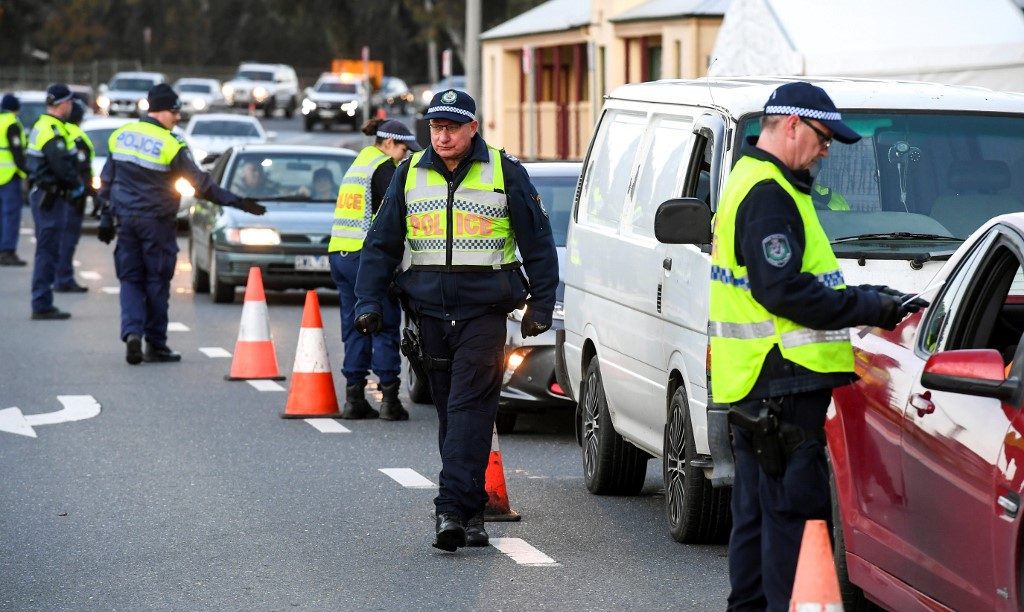SUMMARY
This is AI generated summarization, which may have errors. For context, always refer to the full article.

MELBOURNE, Australia – Shoppers in Australia’s second-biggest city stripped supermarket shelves Wednesday, July 8, as millions in Melbourne prepared for a return to virus lockdown, with warnings the new restrictions will cost the economy Aus$1 billion a week.
Five million residents were ordered back into a six-week lockdown beginning midnight Wednesday into Thursday as soaring community transmission of the coronavirus brings more than 100 new cases daily.
A further 134 infections were detected in the past 24 hours – small in comparison to the tens of thousands in hard-hit countries like the US and Brazil but considered a major spike in Australia, which had otherwise been successful in containing COVID-19.
The country’s largest supermarket chain, Woolworths, said it had reimposed buying limits on items including pasta, vegetables and sugar after shoppers rushed to stores across Victoria state.
Experts have warned that people everywhere will have to get used to the “new normal” of on-and-off restrictions as new clusters emerge and subside, while there are also concerns over the economic and health impacts the measures will bring.
Treasurer Josh Frydenberg said the Melbourne lockdown would cost the economy up to Aus$1 billion ($700 million) a week, telling public broadcaster ABC the burden would “fall heavily on businesses”.
Restaurants and cafes will be limited to serving takeaway food, while gyms, beauty salons and cinemas will be forced to close again.
Residents will be restricted to their homes except for work, exercise, medical care or to buy essentials – a return to social isolation that was only recently lifted.
Professor Michael Kyrios, a clinical psychologist at Flinders University, warned that Victoria needed to brace for a “coming mental health crisis” as a result.
“This will likely place the mental health care system in a precarious situation with very limited ability to mobilize resources in response to the increased incidence of mental illness arising from the COVID crisis,” he said.
State Premier Daniel Andrews on Wednesday acknowledged the costs to Victoria’s 6.6 million residents, saying his job required him “to make not just the popular calls, but the really difficult, the hard calls”.
“This is not the situation that anybody wanted to be in but it is the reality that we must confront,” he said.
“To do otherwise is to pretend that this isn’t real, to pretend that we have other options.”
Health authorities say they have linked many of the Melbourne cases to hotels where residents returning from overseas were being quarantined.
Local media reported security guards had breached infection control protocols – including allegedly having sex with guests being held in isolation – prompting the government to replace the private contractors with prison staff and launch an inquiry.
But there is also concern over the increased community transmission in Melbourne, with just 11 of Wednesday’s new cases linked to known outbreaks.
Around 3,000 people in the city have already been locked inside their homes since Saturday in Australia’s strictest coronavirus response to date after a cluster emerged in a high-rise public housing estate.
A total of 75 cases have been detected in the densely populated towers during a major testing blitz.
Long queues of cars were backed up at Victoria’s border Wednesday after neighboring New South Wales closed the boundary for the first time in the pandemic – essentially sealing off the state from the rest of Australia.
The hastily announced decision left residents of border towns scrambling to obtain permits to cross for work or other essential reasons, while school holiday travellers were rushing to return home.
Australia has recorded almost 9,000 cases of COVID-19 and 106 deaths from the virus. – Rappler.com
Add a comment
How does this make you feel?
There are no comments yet. Add your comment to start the conversation.